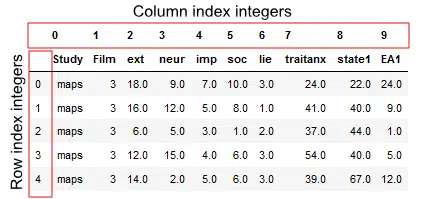Are you wondering how to slice a DataFrame in Pandas on Python? We’re here to help!
Handling large DataFrames for processing and filtering can be arduous, especially when there’s practically no way of thinning the work. You sit in your chair, don your programming glasses 🤓, and get ready to convert the raw form of data into something more useful.
You try using the generic Python nomenclature for slicing lists — all to no avail 🥺.
Since Pandas is a great library, its slicing mechanisms have predefined functions.
According to reports, the generic Python and Numpy operators [] are enough to access most of the indexing features of the Pandas library. However, in this case, the data isn’t known in advance. 😔
Therefore, you won’t be able to slice arrays using the standard index methods. This usually happens because slicing is a three-step process instead of one:
- Finding the specified index within the data.
- Re-copying the sliced data in another array.
- Swapping the pointers to point towards the new array.
With that said, this article will list all the ways that allow you to slice a DataFrame in Pandas.
Therefore, let’s jump into how a DataFrame is usually formed.
Note: This guide caters to all forms of data slicing techniques present within the Pandas library. Since Python is a standalone programming language, it doesn’t matter whether you try it on Windows, Mac. iPhone, or even Linux.
Table of Contents
How to Create a DataFrame in Pandas?
1. Have the Latest Pandas Version Installed
Firstly, you must ensure that the latest Pandas version is installed on your computer. This can be checked by typing the following in a Python Interpreter:
import pandas pandas.__version__
Once executed, the Interpreter will output a decimal version number that can be checked from Pandas’ official page. If the number is lower, then you might want to execute the following statement in the environment terminal:
pip install pandas
Doing so will cause the Python Console to fetch the latest version of the library.
2. Import a DataFrame in Python
You would need to import your desired dataset to slice it. Since Pandas have unique methods of storing and managing datasets, it can be tricky to translate something from a data file to Pandas.
However, this is not the case for a CSV file, making it the gold standard for datasets.
With that said, you need to type in the following command in your script to load a dataset in Python:
Import pandas as pd
Filename = “name_of_the_file” # replace the text with the actual name of the file
Data_set = pd.read_csv(f”{filename}.csv”)
3. Creating a DataFrame Manually
Once you have all the data locked and loaded, creating a more readable DataFrame can help you in your subsequent analysis and vice versa.
To do this, you would need to create two series and interlink them with the help of a dictionary-based data frame.
Here’s how you can perform this to create dummy data of the number of cars in a race 🤓 :
Icolors = pd.Series([“Red”, ”Blue”, “Yellow”, “Black”])
cars = pd.series([23, 44, 27, 32])
pd.DataFrame({“Colors: colors, “Cars” : cars})
How to Slice a DataFrame in Pandas?
Pandas feature dedicated functions for slicing arrays – known as ‘loc’ and ‘iloc’. While their purpose is rather identical, there are a select few differences in the way they handle data:
1. Method 1: Using iloc to Slice a DataFrame
The iloc function allows selecting specific rows and columns in a dataset. A DataFrame in Pandas is essentially stored as follows:
Unlike its competitor, iloc will always consider the names and labels of the columns’ index while slicing DataFrames.
Therefore, you can select certain rows and columns by using the following statements:
DataFrame.iloc[2] # The 2 here represents a row index.
Now, let’s dig in a bit deeper 🧮. Let’s say we want to select a few rows and a few columns instead of just one. Here’s how Pandas’ iloc function tackles that:
DataFrame.iloc[1:3, 0:6] # Where DataFrame is an object, 1:3 is the row range, and 0:6 is the column range.
2. Method 2: Using loc to Slice a DataFrame
Unlike iloc, the loc function works on words and labels. You specify a bunch of headings, and it slices them at your behest.
Despite not-so-fancy, the loc function allows you to get out of the general nomenclature and custom-select rows and columns in a single call. 😮
With that said, here is how you can slice off a single row with loc in Pandas:
rowname = ‘label-of-the-row’ # Replace the text with the actual label of the row
DataFrame.loc[f’{rowname}] # The DataFrame here is the object
Consequently, you can also use a list of labels, for instance [‘x’, ‘y’, ‘z’] instead of just one.
This makes it pretty similar to iloc and can allow you to select a bunch of rows and columns in the following way:
row_list = [‘a’, ‘b’, ‘c’] # The list of row labels. By default, they’re numbered, so the 1:3 notation can also work. column_list = [‘hen’, ‘barn’, ‘yacht’] # The list of column labels DataFrame.loc[row_list, column_list]
Conclusion
In essence, the Pandas library behaves differently from standard list manipulation. However, it is still a devout follower of the nomenclature in Python. Therefore, it’s all about knowing where to pass the indexes as arguments and where to pass the labels as arguments.
With that in mind, we’ve kept this guide as simple and to the point as possible to ensure you understand how to slice a DataFrame in Pandas on a ground level.
Before proceeding with your logic derivation, don’t forget to run your script to check if it’s working.
In case you find the mentioned statements aren’t working in any way, be sure to check whether you’re following the 0 as a starting position convention or not.
Lastly, let us know in the comments:
- Were you able to slice a DataFrame in Pandas?
- Do you have a simpler method of slicing?
- What kind of project are you currently working on that requires slicing?
- Are there some points you think we should add to the list?
Feel free to share this post with your groupmates struggling with slicing DataFrames.













